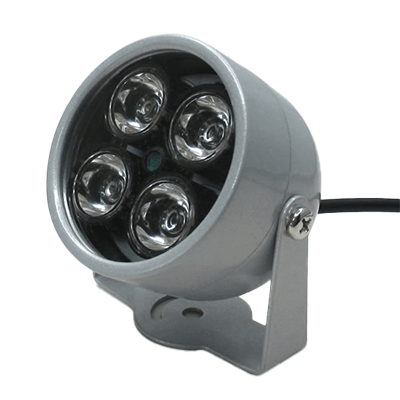What Is an Infrared Irradiation Device?

An infrared irradiation device is a device used to irradiate an object or human body with infrared light.
Infrared light is a type of light that is invisible to the eye, has a longer wavelength than visible light, and is detected as heat energy. The device is used in a non-contact manner, so there is no need to touch the object or subject directly.
This makes it possible to measure and inspect objects and the human body in a non-invasive manner. It also allows measurements and inspections to be performed in a short period. Since infrared rays propagate at the speed of light, data can be acquired in real time.
Uses of Infrared Irradiation Devices
Infrared irradiation devices are used in a variety of applications. The following are some examples of uses:
1. Medical Care
Infrared irradiation device technology is used in medicine. Near-infrared rays are said to be able to reach deep into the body, and devices capable of spot irradiation at high power are already being used in medical institutions. During treatment, it is possible to heat only the affected area irradiated by near-infrared rays.
The effect is said to be to improve blood circulation in the painful area and alleviate symptoms. Irradiation of the stellate ganglion in particular is widely used for its effectiveness in improving blood flow. The main feature of this treatment is that it is less burdensome to the patient compared to treatment involving injections.
2. Cameras
Infrared irradiation devices are used to illuminate security cameras and black-and-white cameras. When used in conjunction with an infrared-compatible security camera or black-and-white camera, it is possible to take pictures without being affected by darkness or haze.
However, care must be taken with the infrared irradiation distance, as photography is not possible if the infrared light cannot reach the camera. The irradiation distance listed in the product specifications is often the maximum value, so it is necessary to select a product with a sufficient irradiation distance.
3. Environmental Monitoring
Infrared sensors are often used for environmental monitoring. Infrared spectroscopy is used to detect gas components and pollutants in the atmosphere. Infrared sensors are also sometimes used in earth observation and weather forecasting.
Principle of Infrared Irradiation Devices
The principles of infrared irradiation devices can be divided into the use of thermal radiation, reflection, and spectroscopy.
1. Use of Thermal Radiation
The use of thermal radiation is to measure the infrared radiation that an object radiates in response to its temperature. The higher the temperature, the more infrared energy is radiated. Infrared irradiation devices can detect the infrared radiation emitted from an object and measure its temperature.
2. Use of Reflection
Reflection is used to evaluate the properties and state of an object by irradiating it with infrared light and observing its reflection pattern. The reflectance or absorptance of an object’s surface is related to its chemical composition and surface condition.
3. Use of Spectroscopy
Spectroscopy is a method for measuring the absorption spectrum of a material at different infrared wavelengths. Substances absorb infrared radiation at specific wavelengths and transmit or reflect infrared radiation at other wavelengths. Infrared spectrometers analyze these absorption spectra to identify substances and measure their concentration.
How to Choose an Infrared Irradiation Device
There are many factors to consider when selecting an infrared irradiation device. The following is an example of factors to consider when selecting:
1. Purpose of Application
The specific purpose for which the infrared irradiation device will be used must be clearly defined. In the case of the medical field, medical purposes may vary, such as measurement of body temperature or evaluation of blood flow. It is also important to select products that are harmless to the human body. In the industrial field, select a device suitable for purposes related to the production process, such as temperature monitoring or evaluation of material quality.
2. Measurement Distance and Accuracy
Depending on the size and distance of the object or area to be measured, it is necessary to select a device with an appropriate measuring range or distance range. Measuring an object outside the range may result in inaccurate results.
Also, check the measurement accuracy and resolution of the device according to the required measurement accuracy. Especially when high precision is required for medical or scientific research, it is important to select a device capable of precise measurement.
3. Functions and Operability
The functionality and operability of the instrument are also important factors. Check to see if the instrument has an easy-to-use interface and the necessary functions.
Power supply is also an important factor. For portable equipment, check battery capacity and battery specifications. For fixed-set type, check the power supply voltage and required power capacity before selection.
4. Wavelength Band
The absorption and reflection characteristics of materials differ depending on the wavelength band of infrared radiation. Depending on the application, a specific wavelength band device may be required.
The near-infrared wavelength band is about 0.75 μm to 1.4 μm. It is absorbed by optically transparent materials, but penetrates some semiconductor materials and biological tissues. Applications include measurement of tissue oxygen saturation in medicine and optical communications.
The wavelength range of mid-infrared rays is from 1.4 to 5 μm. It is absorbed by many materials, but some window glass and transparent plastics can penetrate it. It can be applied to material analysis and fire detection.
The wavelength range of far-infrared radiation is from 5 μm to 1,000 μm. It is used to evaluate thermal radiation and material properties. It is applied to thermal imaging and infrared thermography.